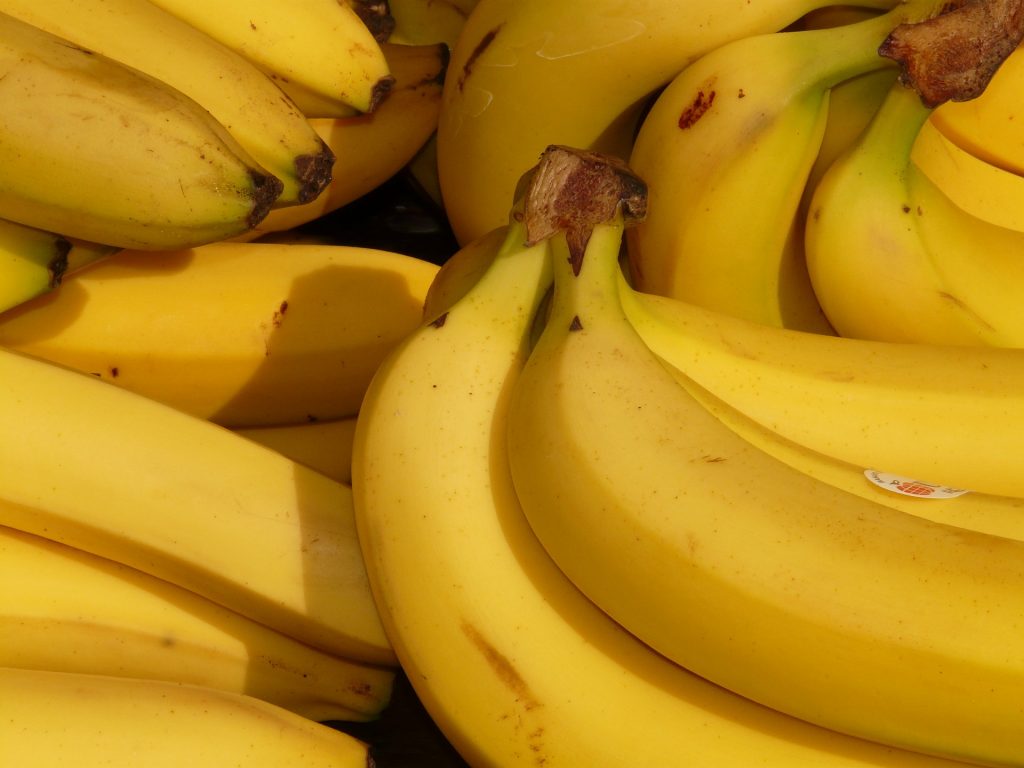Bananas are tropical fruits that are protected by an easy-to-peel skin. The skin will change from green to yellow as the banana ripens. As the ripening process continues, dark brown spots form on the peel.

Health Benefits
Bananas are a good source of potassium, fiber, manganese, and vitamins B6 and C. They are also a naturally fat-free, cholesterol-free, and sodium-free fruit. The unique texture and mix of vitamins, minerals, and fiber make bananas a good choice for nearly everyone–from infants and the elderly to endurance athletes!
- Eating fruits that are a good source of potassium, such as bananas, can help maintain normal blood pressure and heart function, as well as protect against kidney stones.
- The fiber in bananas has been shown to promote overall digestive health and regular bowel function.
Selection
Personal preference is important when choosing bananas, as well as considering how and when they will be used.
- Avoid buying bananas that show signs of handling damage, like a soft spot or large brown area.
- If not to be eaten immediately, it is usually best to choose bananas that are slightly green at the stem end, enabling them to be enjoyed over the next few days as they continue to ripen.
- For baking or making smoothies, ripe bananas offer the best texture and flavor.
Storage
Fresh bananas can safely be stored on the counter at room temperature for up to a week, or until the skin becomes dark brown or over-ripe. Make sure to remove bananas from plastic produce bags as this speeds ripening. It is also not recommended to refrigerate bananas because the cold temperatures can affect the ripening process.
- Once bananas are over-ripe, they can be mashed and used immediately (or packaged and frozen for later use) in your favorite desserts and smoothies.
How to Freeze Over-Ripe Bananas
Not sure what to do with the over-ripe bananas? Instead of throwing them out, freeze them! Here is a simple way to freeze and store bananas:
- Peel the bananas.
- Slice bananas into a size that will accommodate their later use:
- 1 to 2 inch chunks are easier on the blender when making smoothies.
- Whole bananas or larger chunks can be ideal for baking or for cold, nutritious desserts—like banana ice cream (scroll down for a delicious recipe).
- To ensure that they do not fuse together while freezing, line up the banana pieces on waxed or parchment paper on a baking sheet and place in the freezer.*
- After two hours or when solid, remove the banana pieces from the parchment paper and place inside freezer-safe bags or containers.
- Place bananas back into the freezer where they will store well for up to 6 months.
*If you do not have parchment or waxed paper, you can skip step 3. However, make sure to cut your slices 2 inches or thicker to make them easier to pull apart if they fuse together while freezing.
Scrumptious Three-Ingredient Banana Ice Cream
Perfect for summer, this three-ingredient recipe is an excellent addition to your collection!
Ingredients:
4 medium size ripe bananas (frozen)
1 tsp. vanilla 1 Tbsp. peanut butter
Directions:
- Peel and freeze bananas (in about 1 inch chunks).
- Place the frozen banana chunks into a large food processor.
- Puree until consistency is smooth and similar to ice cream.
- Add vanilla and peanut butter, and process until well-blended.
- For best results, serve immediately.
Recipe from our partners at the Kendall Reagan Nutrition Center.
A Great “On-The-Go” Fruit
Have a busy day ahead of you?
Grab a banana and eat it on the way out of the house, or take one along for a mid-morning snack. Bananas also make great portable snacks for your next outdoor adventure or athletic event.


